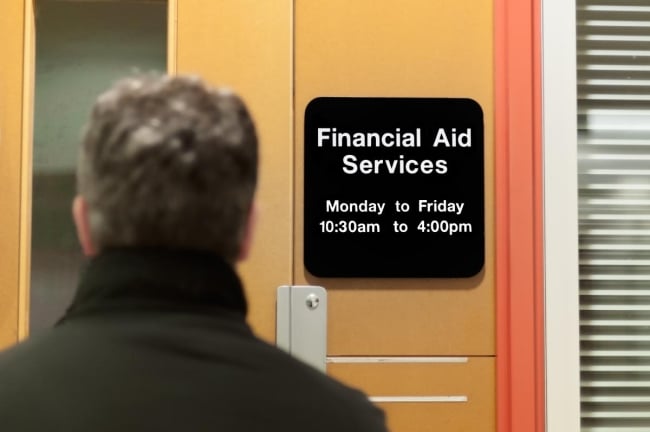You have /5 articles left.
Sign up for a free account or log in.

PamelaJoeMcFarlane/iStock/Getty Images Plus
Four bipartisan bills were introduced in Congress last week that all aim to increase the transparency of information that students receive about the cost of and payment for college throughout their postsecondary education -- a change that experts and advocates say would be helpful but still wouldn’t solve the student debt crisis.
Senators Chuck Grassley and Joni Ernst, both Republicans from Iowa, alongside Senator Tina Smith, a Democrat from Minnesota, introduced three bills April 29 -- the Net Price Calculator Improvement Act, the Understanding the True Cost of College Act and the Know Before You Owe Federal Student Loan Act.
A day earlier, the Student Loan Disclosure Modernization Act was reintroduced by Representatives Emanuel Cleaver, a Democrat from Missouri, and Jim Banks, a Republican from Indiana, along with Senators Tim Scott, a Republican from South Carolina, and Joe Manchin, the Democrat from West Virginia.
The bills would provide clearer information about college finances to students, beginning with their search of prospective schools and continuing until they graduate. Congress has already made part of the financial aid process easier by passing legislation in December that will simplify the Free Application for Federal Student Aid from 108 to 36 questions.
“All of this is critically important to get clear information to students at different points on their financial aid trajectory through their postsecondary experience,” said Laura Keane, chief policy officer at uAspire, a nonprofit that advises about 10,000 students per year on how to pay for college.
That begins with the Net Price Calculator Improvement Act, which would make online net price calculators more user-friendly and accessible, allowing students to understand the net price of attending different colleges before deciding where to apply.
Institutions would be required to put their calculators on webpages where prospective students would be most likely to search for cost information and to make the net price the most prominent figure on the results screen. Currently, they are required only to be on the site somewhere. The bill also authorizes the Department of Education to create a universal calculator that would allow students to answer one set of financial and academic questions and receive a list of net price estimates for multiple colleges.
Once students are accepted to a college and receive a financial aid package, the Understanding the True Cost of College Act would provide clarity on the price tag of their college education and standardize that information so that it can be compared between institutions.
“When you buy a car, you walk up to a car and you see a window sticker that has common terms and common definitions presented in a common way,” Keane said. But that’s not the way it works for higher education, where a lack of federal regulations means that some financial aid terms -- like net cost -- may have different definitions and calculations at different institutions.
“It's really difficult for students to make that comparison without doing a lot of digging around and figuring out terms and calling the financial aid office,” said Michele Streeter, senior policy analyst at the Institute for College Access and Success.
The Federal Student Aid office issued recommendations in April 2019 for colleges to help make their financial aid offers clearer for students. The Understanding the True Cost of College Act would go much further by requiring institutions to use a uniform financial aid offer form with basic minimums of information that must be included on the first page, including cost of attendance, grant aid and the net amount that a student is responsible for paying after grant aid is subtracted, among several others.
The standardization would be especially beneficial for low-income students, predominantly students of color, who aren’t making college decisions based on their acceptance letters but on their financial aid offers.
“Making sure that financial aid offer is as clear and as crisp as an acceptance offer -- which is a little simpler, of course -- really is essential,” Keane said.
Then, if students have to take out loans to pay for college, the other two bills are intended to provide clearer information about the process and outcomes throughout their time in school. The Know Before You Owe Federal Student Loan Act would make loan counseling an annual requirement before each time new loans are disbursed, rather than only for first-time borrowers. The bill would also add required information that colleges must share with their students during loan counseling, including the student’s estimated monthly payment after graduation, options for reducing borrowing and a statement that the student should only borrow the minimum amount needed to cover expenses and that they don’t have to accept the full amount of offered loans.
Students would be required to manually enter the exact amount of federal loan funding they want to borrow to ensure “students make a conscious decision about how much they borrow rather than simply accepting the total amount of loans for which they are eligible,” said a summary of the legislation.
The Student Loan Disclosure Modernization Act would help student borrowers have a clearer understanding of the terms and conditions of a loan agreement before signing it. It would simplify the Education Department’s Plain Language Disclosure Form and require it to be consumer tested, placing a greater emphasis on the material terms of the loan like the finance charge, annual percentage rate and estimated monthly repayment. Borrowers would have to sign the form every time they take out a new loan.
“By giving those seeking higher education more tools to see what their student borrowing really means, we can remove some of the uncertainty that they face after graduation,” Scott said.
And while the legislation could go a long way in improving financial transparency for students, both Streeter and Cody Hounanian, program director at Student Debt Crisis, said the bills still don’t address the root of the student debt problem.
“These are some of our best and brightest among us and yet, they still struggle to completely understand their options and to navigate the student loan system,” Hounanian said. “It goes far beyond just lack of information. It's a fundamental problem with how complicated and frankly, how predatory some of the parts of our student loan system are.”
Streeter noted that many students and families will still have to take out loans and accrue debt, regardless of whether they understand the information about it.
“For so many students, it's just the choice between going to college or not,” she said.








